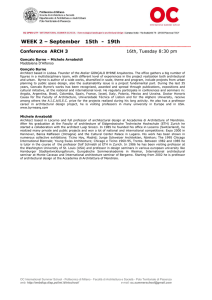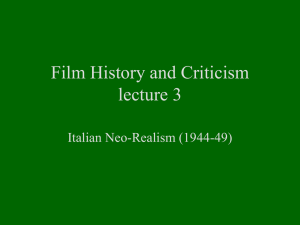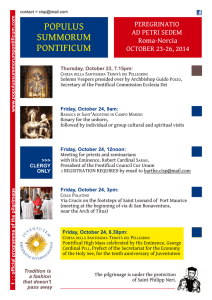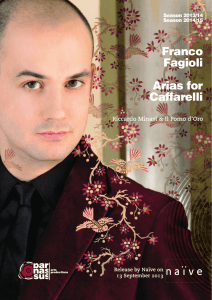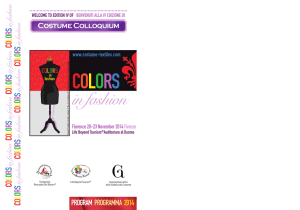pitti i immag gine : w where e it all l bega an
advertisement
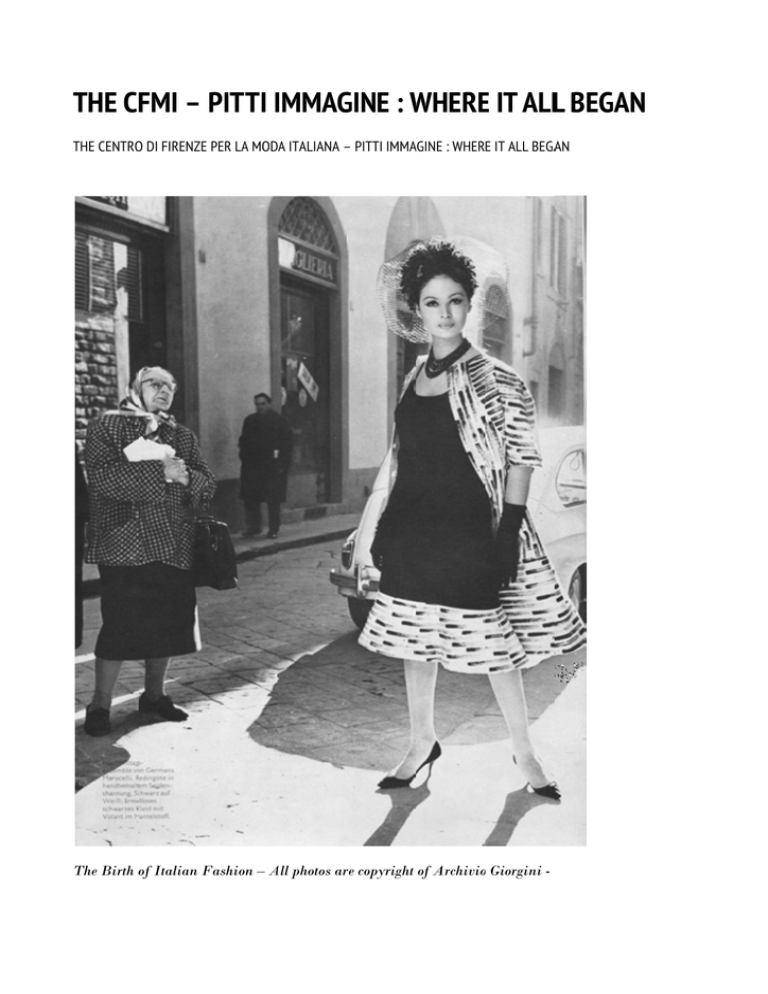
THE CFMI – PITTI IMMAG I GINE : WHERE W E IT ALLL BEGA AN THE CENTRO O DI FIRENZE PER LA MOD DA ITALIANA – PITTI IMMAAGINE : WHERE IT ALL BEGAAN The Birth oof Italian Fashion F – All A photos arre copyright of Archivioo Giorgini - Florence trruly is a hoome for artiists and arttisans, for whatever w th he reasons m may be thatt this particular city has prroduced succh a wealth h of skill and d creativity y, what we do know is that it’s a story that has been centuries in the makingg. Evidencee of the artisan traditiions of crafftsmanship and beauty y produced d with innov vative pracctices and creativity ca an be foundd as far bacck as the Etruscan aart of cast and a engraved bronze ssculptures and a mirrorss from 500 B BC and this tradition of excellen nce in art haasn’t ceased d since. Thee Renaissan nce and thee great artissts Michelangelo, Leonardo da Vinci, Botticelli B an nd Giotto arre all spark kling stars in n Florence’’s great histtory. The Birth oof Italian Fashion F – All A photos arre copyright of Archivioo Giorgini - In the morre recent 19920s Floren nce was a citty filled with ateliers, San Frediaano, the OlttreArno, Santa Crocce were busstling with hundreds oof artisans working w witth hand skiill, capabiliity, knowledgee of materiaals, particullarly of leatther, that had h been pa assed on thrrough the years. y It was in tthis time, 19922, that Giovanni G Baattista Giorrgini began trading in these artisan crafts with Amerrica, openin ng his first office o theree in 1923 an nd selling to o departmennt stores su uch as Tiffany wh ho bought from f him siilverware aand jewellerry. In the postt second woorld war peeriod the woork of the Artiginato A Artistico A waas fundameental to the city off Florence’ss economy and a Giorgin ni was fully y aware of the importaance of an internation nal trade. He H had esta ablished a w wide circle of o connectio ons with Am merican bu uyers and with the administratiion that wa as actively iinvolved in n the reconsstruction off Italy afterr the war under the Marshall Plan. P In the spring of 11944 the Allied Army requested r tto use Giorg gini’s homee for their headquarterrs as it was situated in n a strategicc position on the BellooSguardo hiill facing south and overlookin ng Porta Ro omana. As a true eentrepreneu ur, Giorginii immediateely started collaboratiing with theem and a year y later he opened the first giift shop in Florence, F in n Via Calzaiuoli and in n the buildinng now occcupied by Coin. Therre he organised the sto ore as a fairr of sorts by y giving thee artisans sttands where they were able, not only too sell their products p bu ut also, to work w and sh how the buuyers first-h hand their craftsmanship, this was w the firstt artisan m arket of its kind in Flo orence. It w was not only y in the interest off soldiers wiishing to brring home ggifts of Florrentine leathers, bags, lace and sttraw boater hatts, but as a strategic move m of his own to help p restart th he economyy. In turn th his move led him to realise the importancce of fashion n in new poostwar socieety and so G Giovanni Battista B Giorgini pllanned his greatest strrategic mov ve: to create and exporrt Italian F Fashion. Departure of the USA A Tour to proomote Giorggini’s busineess. The Birth of Italiaan Fashion – All photos are copyright off Archivio Giorgini G - We spoke to the gran ndson of Gio ovanni Batttista Giorggini, Neri Fa adigati, whho in 1990 rediscovered his gran ndfather’s vast v collectiion of photoographs, pa apers and m memorabilia a from the very begin nning with his h first fashion show in Villa Torrigiani, that had beenn quietly sttored away for twenty y years in th he home of his aunt. H He immediaately realiseed its culturral importa ance and, after makiing an agreeement in 20 005 with Arrchivio di Stato S Firenze, they be gan to scan n and catalogue the collectiion. Neri tells us theree are still th housands off documentss and photo ographs to sort througgh and cataalogue. In converssation with Mr Fadiga ati in the flooral courtyard of his hotel h Resideenza Il Villino in Central Florence, he spoke s affecctionately aabout his grrandfather and growinng up in thee beautiful and interesting environment he created at Villa Torrigiani. hing was beeautiful, his house; hee was also an expert an ntique colleector, this fa ashion “…everyth world, the women, th heir elegantt dresses an d they had a lot of fun n partying and organising those big balls. S Still the atm mosphere was w very intteresting, ev verything had h to be peerfect, this is somethingg I remembeer very well everythin ng has to bee perfect plu us it is veryy importantt to work hard to doo what you have to do at your be st but also to enjoy liffe to be nicee to yoursellf to others it was a veery positivee environmeent. My grandffather’s dreeam was to start a dipllomatic carreer, to be a diplomat,, but becausse of the war he cou uldn’t so hee said ‘I will sell Italian n products abroad and d this is a w way to be diplomatic’, and in factt he did thaat very very y well …hee was very good g in inteeracting witth people and a he also paid good attention to t others … and probaably this is one of the reasons r he w was so succcessful because off that so thee people weere always h happy to coome to Florrence to com me to his house to work with him becau use it was a pleasure.” Gloria Swaanson and G.B.Giorgin G ni at his hom me in 1955.5.10 – All images i are ccopyright off ArchivioGiorgini matic ability y Giorgini w was able to gather togeether both emerging and a known Thanks to his diplom fashion designers such as Emilio o Pucci, Sorrelle Fontan na, Emilio Schuberth,, Simonetta a Visconti, Jole Venezziani and Roberto R Cap pucci, amon ngst others and set abo out organissing Italy’s first commerciaal fashion show to be hosted h in hiis own hom me Villa Torrrigiani in F February 19 951. “He realiseed that society was ch hanging com mpletely, hee was a bussinessman ffirst of all… … his goal was to creaate businesss to generate wealth n not only forr himself bu ut also for tthe others… …and so as a businessm man he reaalised that there t was a huge new market m opeening up in the States,, no more just high ffashion and d unique pieeces made in n France an nd Paris for going outt at night but everyday ffashion and d he realised d that ‘…iss going to become b a big business iin the futurre and we can do thiss, we are goood in it, wee can produ uce …’. G.B. Giorggini with US S Ambassad dor Reinharrdt in 1953 – All photos are copyrig ight of Archivio Giorgini he world’s fashion f capiital, in the ppost-war period it Although Paris neverr lost its position as th h production costs, sellling its luxu ury collectiions when tthe averagee personal was hinderred by high income ratte had fallen dramaticcally and reestrictive poolicies impo osed by the Chambre Syndicale S de la Modee Français on o the licen nsing, reprooduction an nd exportation of Frennch designs. This decline in tthe Parisian monopoly y and hautte-couture, coupled with an increaasing dema and for affordable, high quallity fashion and day-w wear, opened a window w of opportuunity for co ompetitors and therein Giorgini find f his cha ance to brin ng forth thee Made In Italy I brandd. here was th his change and a he thou ught… he used u to sell to North A American deepartment “He saw th stores, maglieria from m Como, Leecco, Milan,, the North h Italy …so customerss used to come and n to hav ve a Frenchh name for this t brand say ‘This iis beautiful, the qualitty is beautifful but we need otherwise it won’t selll’. So somee Italian prooducers useed French names, n he w was mad about that he said: ‘N No! We musst produce under u Italiaan names and if we wiill be able too sell fashio on this will pull in eveerything elsse’, so he ussed Fashion n to create Made M In Ita aly as a braand he realiised fashion waas the only tool to be used u to do tthat, just Fashion, F he realized thhat Fashion n had a leading rolle. His goal w was not justt to launch Italian fash hion, his gooal was to make m Made In Italy strong and big in ordeer to sell everything, not n just fash hion…” L’Europeo Newspaperr showing a headline reeading “Thee War of thee Tailors” 0 1.01015 – All photos are copyrigght of Archivvio Giorginii All photos are copyrighht of Archivvio Giorginii Illustration n drawn by the famous fashion f shoow sketch arrtist Brunettta Marucellii – Linea Banjo B “Banjo Lin ne” from Caapucci collection 1956 – All photoss are copyrigght of Archiivio Giorgin ni Capucci – 1959 – All p photos are copyright off Archivio Giorgini Illustration n drawn by the famous fashion f shoow sketch arrtist Brunettta Marucellii – Linea Crisalide “Chrysalis Line” 19566 – All phottos are copyrright of Arcchivio Giorgiini So it was on February 12,1951, in his home of Villa Torrigiani, that Giovanni Battista Giorgini held Italy’s first fashion show featuring 180 collections, several female buyers from elite North American department stores including Jessica Davis of Bergdorff Goodman, Gertrude Ziminsky of New York’s B. Altman and Stella Haniania of San Francisco’s I.Magnin, and a few international journalists. Giorgini had used his connections and charm to convince these high profile buyers to attend his first show in Florence as they were already in Europe for the Paris collections. In the 1950′s, a journey from America to Europe was a long boat trip followed by a long train ride so Giorgini who was used to hosting international buyers in his home, invited his guests for elegant supper at his home and held grand evening balls to entertain his clients as much as to showcase the fine Italian fashion. Despite the small number of designers and buyers, the event proved to be a great success. All the collections shown that evening were sold, the buyers contacted their stores to send more funds and the ateliers were inundated with orders. The event gained extensive media coverage in international fashion magazines such as Fashion trade publication, Women’s Wear Daily’s follow-up headline: “Italian styles gain approval of US Buyers.” Giorgini’s initiative had proven successful in introducing sophisticated Italian fashion, quality fabrics, skilled technical tailoring and many view this event as the official birth of Italian fashion. First Italiaan High Faashion Show w in Giorgin ni’s home Villa V Torrigiani, Firenzze – All phottos are copyright of Archivio Giorgini G After the ssuccess of th his first fasshion show,, Giorgini quickly q orga anised a seccond show in i July, 1951. Thiss time the event took place p at thee Grand Hootel in Floreence, a biggger venue ca apable of hosting th he growing attendance a , there weree around seeventy buyers and jouurnalists and d included designers ffrom Romee, Milan, Tu urin, as welll as Florencce. Ferragamo, made tthe shoes while w Emilio Pucci presented his first full collectiion. Tenth Italiian High Fashion F Show w, Sala Biaanca, July 1955 1 – All photos p are coopyright of Archivio A Giorgini Tenth Italiian High Fashion F Show w, Sala Biaanca, July 1955 1 – All photos p are coopyright of Archivio A Giorgini In July 1952 in the beautiful Sala Bianca of Palazzo Pitti, Giorgini’s fourth fashion show was a pivotal event for his enterprise with nine fashion houses participating, along with sixteen houses showcasing boutique styles and sportswear, Florence became the place where all the major Italian fashion shows were held up until 1982 in the Sala Bianca in Palazzo Pitti. In 1954 Giorgini and his collaborators realised it was necessary to organise this growing wave of fashion business and together they founded the Centro di Firenze per la Moda Italiana (CFMI) designed to promote the fashion events. From then on, this organisation would promote all the fashion events. There were 500 buyers and 200 journalists at the 1955 shows, making “Pitti” the biggest fashion trade fair in Europe. Now sixty years on the CFMI and Pitti Immagine, are still going strong and the Palazzo Pitti Fashion shows have grown to include Pitti Uomo in 1972 at the Hotel Villa Medici, Pitti Donna in ’75 at Palazzo Strozzi, Pitti Bimbo in ’75, Pitti Filati in ’77, Pitti Casual in ’78 and Pitti Maglia in ’82 devoted to Italian knitwear. Italian fashion has influenced the world’s designers and fashion admirers, setting a standard of excellence in style and production that has withstood the threat of fast fashion, cheap counterfeiting, economic pressures and more. With such a wealth of natural talent and innate style Italian designers such as Versace, Ferragamo, Gucci, Emilio Pucci, Cavalli etc. have deservedly become the stars of the fashion world and it’s difficult to talk about fashion without mentioning their influence so let’s also tip our hat to Count Giovanni Battista Giorgini, the great man who had the vision and charisma to create the international platform for Italian Fashion to stand proudly on. Neri Fadiggati with thee original Capucci creaation on disp play at his Hotel Villa – photo by Fashion Spyder Special thaanks to Nerri Fadigati for his tim e and information. Neeri, in collabboration wiith Raffaello N Napoleone,, chief execu utive of Pittti Immagin ne, have pu ublished som me of the processed p photograp phs and doccuments in the t book Th he Sala Biaanca: The Birth of Italiian Fashion n. All photoggraphs are copyright c of o Archivio Giorgini All photoss on this weebsite are co opyrighted material an nd all rightts are reservved. This means m you must havee permission n to use thee photos in any way th hat does not fall underr the limited rights granted by y the “fair use” u clause of the copy yright law. Giorgini’s little red boook of buyerss from Italy’’s first Highh Fashion Show S – All pphotos are copyright of Archivio G Giorgini
